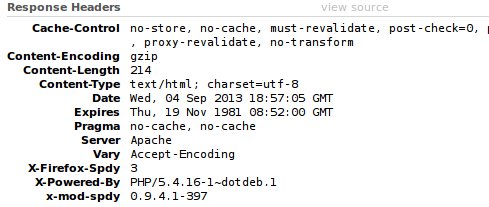Increase SSL https speed by using spdy apache module
Increase SSL https speed by using spdy apache module
I think most of you administrators who have set a SSL certificate for a website so far would know that SSL is slow, damn slow compared to normal request, at least 80% slower. But the very well known company, Google, in their way to speed their servers requests have developed a new way to send requests in a bulk manner, this is called spdy (pronounced speedy). As its name is, it does its job really well, I was really impressed by it myself when I tested it. From a 14 seconds load time, it was reduced to 1.9 seconds. Basically all resources requests were sent to the browser much much faster.
See below video to see its effect:
What are the requirements to use spdy
To be able to use spdy it is required that your browser supports this new protocol. Latest version of Mozilla Firefox and Google Chrome support this by default. Next you need to install spdy on your server, Google has been kind enough to provide us with a beta version of their module for apache webservers.
More information can be found here: https://code.google.com/p/mod-spdy/
How to install spdy on linux centos x86_64 or Debian / Ubuntu
Installing this is not that hard I believe, actually it really is easy, you just need to download the packages for your OS version and install the .deb file or the .rpm file. Bellow you have more detail:
- mod_spdy 32-bit .deb (Debian/Ubuntu)
- mod_spdy 64-bit .deb (Debian/Ubuntu)
- mod_spdy 32-bit .rpm (CentOS/Fedora)
- mod_spdy 64-bit .rpm (CentOS/Fedora)
To install it on your debian based operating system like Ubuntu
|
1 |
dpkg -i mod-spdy-*.deb |
For Centos or Fedora, we need to use:
|
1 |
rpm -U mod-spdy-*.rpm |
And that’s about it, it should automatically enable the module and you just need to restart your webserver and and enjoy your much more faster SSL website. But do keep in mind, if your visitors do not use a browser compatible with spdy, this module has no benefit for them, it will still load slow for them.
For example, you need to be sure your browser uses the following headers to make use of spdy:
You will notice the SPDY headers being added and the spdy module version.
That’s it for now, see you next time with a new article!






